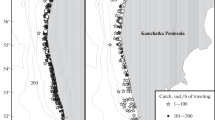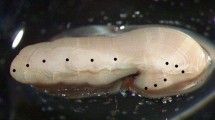Abstract
Delay of upward migration from the coast is considered to be a cause of stunted growth in ayu Plecoglossus altivelis altivelis in the Nagara River. To evaluate the effect of stocked seeds (hatchery reared, originating from Lake Biwa and amphidromous stock) on the growth of native ayu in the river, monthly changes in origin composition and standard lengths of territorial ayu caught by Tomozuri angling were examined. Stock origin of 94 individuals caught in the middle reaches of the river from June to October 2010 were discriminated using the otolith Sr/Ca ratio and morphological characteristics. Percentage frequency of native ayu increased with time from 4.2 % in June to 73.3 % in September and 71.4 % in October. Hatchery-reared stocks were consistently caught throughout the sampling period (26.7–41.7 %), while the catch of both Lake Biwa and amphidromous stocks were limited to before August. Native ayu were significantly smaller than the others in July; however, no significant differences were found from August. Apparent growth of stocked seed stopped after August, while native ayu stopped in September. Thus, we suggest that large stocked ayu disturb the native ayu from making territories and stunt their growth in the early part of the season.




Similar content being viewed by others
References
Miyadi D (1960) The ayu. Iwanami Shoten, Tokyo (in Japanese)
Kawanabe H (1970) Social behaviour and production of the ayu fish in the River Ukawa between 1955 and 1969, with reference to the stability of its territoriality. Jpn J Ecol 20:144–151 (in Japanese with English abstract)
Iguchi K, Hino T (1996) Effect of competitor abundance on feeding territoriality in a grazing fish, the ayu Plecoglossus altivelis. Ecol Res 11:165–173
Taniguchi N, Seki S, Inada Y (1983) Genetic variability and differentiation of amphidromous, landlocked and hatchery populations of ayu Plecoglossus altivelis. Bull Japan Soc Sci Fish 49:1655–1663 (in Japanese with English abstract)
Azuma M (1973) Studies on the variability of the landlocked ayu fish, Plecoglossus altivelis T. et S., in Lake Biwa III. On the differences in the process of maturation, spawning habits, and some morphological features of each population. Jpn J Ecol 23:147–159 (in Japanese with English abstract)
Azuma M (1973) Studies on the variability of the landlocked ayu fish, Plecoglossus altivelis T. et S., in Lake Biwa IV. Considerations on the grouping and features of variability. Jpn J Ecol 23:255–265 (in Japanese with English abstract)
Iguchi K (2011) Ecological approaches to sustain the ayu stocks. Nippon Suisan Gakkaish 77:356–359 (in Japanese)
Taniguchi N, Ikeda M (2009) Study of ayu. Tsukiji Syokan, Tokyo (in Japanese)
Ishida R (1964) On the size of ayu, Plecoglossus altivelis T. & S., caught by ‘Tomozuri’. Bull Freshw Fish Res Lab 14:29–36 (in Japanese with English abstract)
Seki S, Taniguchi N, Murakami K, Yoneda M (1984) Comparative experiments on growth, maturation, and ethological property of landlocked and amphidromous form of ayu, Plecoglossus altivelis. Freshw Fish 10:101–104 (in Japanese)
Ishida R (1988) Ecology and fishing of ayu. Tsuribitosha, Tokyo (in Japanese)
Aino S, Yodo T, Ishizaki D, Yoshioka M (2014) Discrimination of the stock origins and growth of ayu Plecoglossus altivelis altivelis in the Nagara River. Aquaculture Sci 62:89–97 (in Japanese with English abstract)
Hara T, Okazaki M, Ichiyanagi T (1999) Investigation of increase in resources of ayu Plecoglossus altivelis-V. State of fishing for variety of ayu on the midstream of Nagara River. Gifu Prefect Res Inst Freshw Fish Aquat Environ 44:1–7 (in Japanese)
Hara T, Saitou K (2006) Probe of effect on resources of ayu (Plecoglossus altivelis) by fishery-II. The method of origin of the introduced population of ayu and application of the method. Gifu Prefect Res Inst Freshw Fish Aquat Environ 51:11–16 (in Japanese)
Niimura Y (2000) Influence of Nagaragawa estuary barrage construction on the fishes, particularly ayu Plecoglossus altivelis altivelis and amago salmon Oncorhynchus masou ishikawae. The influence of Nagaragawa estuary barrage on ecosystem and conservation of estuary. Nat Conserv Soc Jpn, Tokyo, pp 60–78 (in Japanese)
Koya Y (2010) Influence of Nagaragawa estuary barrage on life history of ayu Plecoglossus altivelis altivelis. The study report of fish fauna in the lower reach of the Nagara River. The Investigation Committee of Fish Fauna in the Lower Reach of the Nagara River, Gifu, pp 54–67 (in Japanese)
Iguchi K, Aino S, Awata S, Yodo T, Tago Y (2011) Recent limited growth of ayu Plecoglossus altivelis observed in Sho River. Aquaculture Sci 59:459–464 (in Japanese with English abstract)
Hubbs CL, Lagler KF (1947) Fishes of the great lakes region. Bull Cranbook Inst Sci 26:1–213
Otake T, Uchida K (1998) Application of otolith microchemistry for distinguishing between amphidromous and non-amphidromous stocked ayu, Plecoglossus altivelis. Fish Sci 64:517–521
Tsukamoto K, Kajihara T (1987) Age determination of ayu with otolith. Nippon Suisan Gakkaishi 53:1985–1997
Iguchi K (2003) Stocking of ayu involving local biodiversity. Aquabiology 25:439–444 (in Japanese)
Seki S, Taniguchi N, Murakami N, Takamichi A, Takahashi I (1994) Seasonal changes in the mixing rate of restocked ayu juveniles and assessment of native stock using an allozyme marker. Fish Sci 60:31–35
Acknowledgments
We thank the Nagaragawa-chuou Fishery Cooperative for providing experimental fishes, and the Nagaragawa Fishery Cooperative, the Gujo Fishery Cooperative, the Itadorigawa-jouryu Fishery Cooperative, the Miyamachou Fishery Cooperative, and the Tsubogawa Fishery Cooperative for providing information about stocking amount. We are also grateful to Dr. Yasushi Harada and Dr. Isao Takahashi for useful advice. Otolith examination was conducted by using the equipment of the Community-University Research Cooperation Center and the Fish Population Dynamics Laboratory of Mie University.
Author information
Authors and Affiliations
Corresponding author
Rights and permissions
About this article
Cite this article
Aino, S., Yodo, T. & Yoshioka, M. Changes in the composition of stock origin and standard length of ayu Plecoglossus altivelis altivelis during the Tomozuri angling season in the Nagara River, central Japan. Fish Sci 81, 37–42 (2015). https://doi.org/10.1007/s12562-014-0822-y
Received:
Accepted:
Published:
Issue Date:
DOI: https://doi.org/10.1007/s12562-014-0822-y




